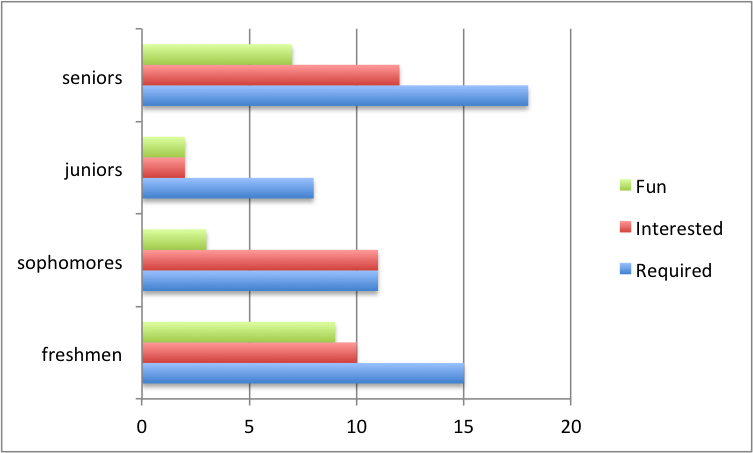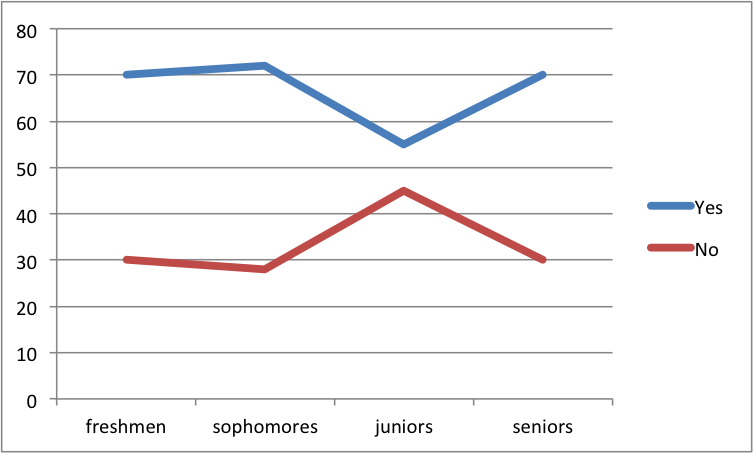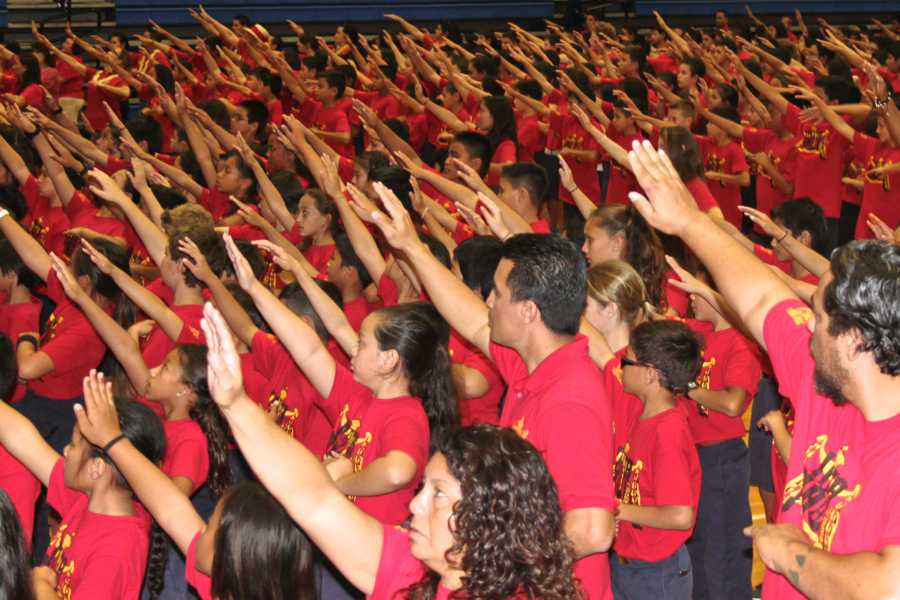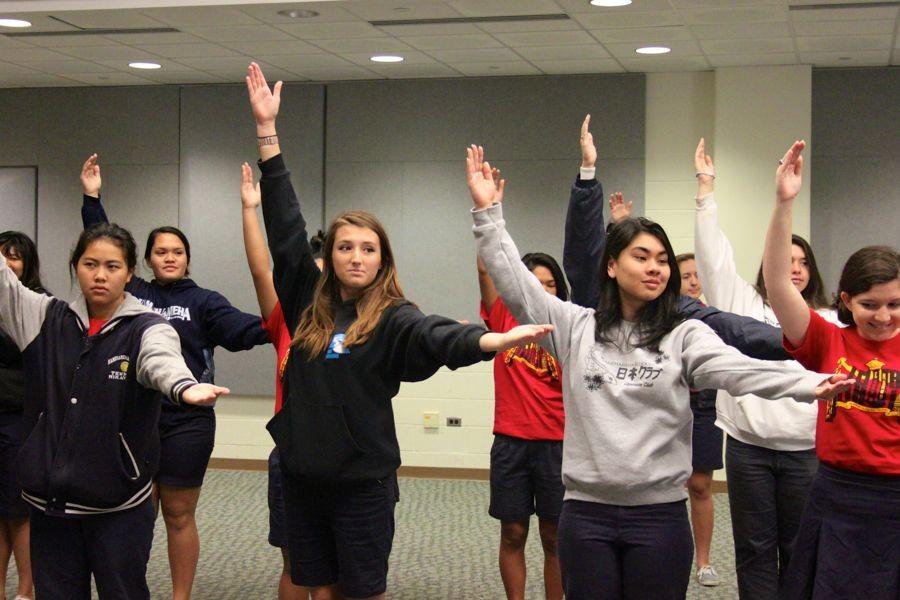Red Friday raises red flags
high absenteeism marks cultural observance
February 11, 2015
This year’s Red Friday was supposed to go off without a hitch. Everything was going according to plan, except for one thing: a staggering 102 students were absent from the high school.
“I don’t think a lot of people realized that this Red Friday was going to be so motivating, and learning about different perspectives toward one issue. I think they just saw it as an opportunity to start their weekend early. I knew that people were not going to show up, but the amount of people that did not show up and called in sick was disappointing,” ASKSM president Haliʻa Kekuewa said.
There were 75 students who called into the absent hotline and 27 who were marked as unexcused, according to Ms. Ronnelle Suda, high school office assistant. However, she said, an unexcused absence could simply mean that the student did attend school, but did not check into first block Friday morning to be counted.
Of the 102 students, 10 were freshmen, 19 were sophomores, 47 were juniors, and 26 were seniors.
“It was unfortunate that a lot of students in the eleventh grade, and some in the twelfth grade werenʻt able to make it that day because they missed out on a lot,” said Ms. Jay-R Ka’awa, academies principal.
Red Friday, which is a day to recognize Hawaiian unity specific to Kamehameha Schools, may revert to an assembly after a day of classes next year, but it could also remain an all-day event depending on the focal point and what the kumu recommend for the theme. Pōʻalima ʻUlaʻula has been conducted both ways in the past, but, Ms. Kaʻawa said, the school will continue to have a Pō’alima ‘Ula’ula event.
After the event, Ka Leo o Nā Koa issued a survey to the four grade levels via www.SurveyMonkey.com. Over a period of two weekend days, 88 students responded; 45 upperclassmen and 43 underclassmen.
Most students, about 60%, reported that they were at Red Friday because it was required or because it was a school day, but many also said they were interested in the topic or attended for the fun and interaction.
Students could report more than one reason for why they attended. In the comments section of this question, many also reported that they came to school because they were involved in athletics over the weekend and would not have been able to play if they were absent. With league championship soccer and basketball games this weekend, the athletes were in full-out attendance.
Of the 88 responses, only five were from absent students. Of those, all five reported that they did not attend due to illness, but they also reported a lack of interest, appointments, and absence of classes as other contributing reasons they weren’t there.
Reasons for Student Attendance at Red Friday, February 6, 2015

In a Ka Leo o Nā Koa survey, students reported that they attended Pōʻalima ʻUlaʻula for the reasons above. The leading reason was that it was a required school day. The survey was completed by 88 students. Respondents were able to select more than one answer. The survey was given via SurveyMonkey.com over a period of two weekend days, February 6-8, 2015.
The students who were absent elaborated somewhat on their reasons for the absence, but since none identified themselves, we are unable to provide their comments here per our editorial policy; however, many students who were present had opinions about why so many people were absent.
“I know that a lot of people were absent because they didn’t think that it was important,” senior Bryant Kubo said. “They donʻt feel like learning a hula has anything to do with school or their education. They thought that going a whole day trying to learn one hula was pointless.”
Was Red Friday beneficial?

The chart above shows the percentage of students by grade who thought that Red Friday was beneficial. The majority of students reported that it was beneficial. The Ka Leo o Nā Koa survey was completed by 88 students. The survey was given via SurveyMonkey.com over a period of two weekend days, February 6-8, 2015.
Except for juniors, about 70% of students reported that Red Friday was beneficial.
“[Itʻs mostly just disappointment] that they maybe not recognize why we have Pō’alima ‘Ula’ula and the reasoning behind it at school. Itʻs not to waste peopleʻs time,” vice-principal Mr. Leo Delatori said. “Thereʻs going to be a time down the road when theyʻll reflect back, and they may recognize that they missed this opportunity. It is more for people to learn and to gain a deeper understanding of who they are.”
Another reason behind the huge number of absences was illness.
Registered Nurse Susan Hardesty, the high school nurse, said she has seen a great increase in the number of students who are absent with the cold, flu, and respiratory illnesses this year over any other year and believes that this is due to the recent clouds of “yucky” vog in the air and winds, which have triggered allergic and respiratory reactions.
The numbers, she said, are getting near the range of mandatory reporting to the Department of Health as epidemic.
Nurse Sue said she has been going through immune boosters and vitamin supplements by “the bottles” and urges students to take better care of themselves. “‘Sleep, fluid, and vitamins’ is my mantra,” she said.
As for the consequences for those who did not attend, according to Mr. Delatori, it has always been a rule that student-athletes not be allowed to participate in sports if they do not attend school on any day that there is a sporting event. However, if students miss school on a Friday, they are not allowed to participate that Friday or Saturday.
Ms. Ka’awa said that leadership was also considering adding Saturday school for students to research and learn about the missed topic in the future and/or making attendance a commencement requirement.
While there were those who came simply because they thought it was a requirement, there were just as many who said they came because it was fun, and they thought it was interesting.
“My favorite part was listening to all the speakers tell their stories,” sophomore Kūpono Aguirre said. “Itʻs important for us to hold steadfast to our culture because we don’t only represent ourselves, but the thousands of ancestors that came before us.”
On Friday, students were broken into four groups: freshmen and sophomores, and juniors and seniors. Then each group was divided into kāne and wahine.
In their groups, students learned the hula for the mele Kaulana Nā Pua and were taught the meaning of each verse by different guest speakers.
The speakers were Naomi “Sissy” Lake-Farm, Kumu Ekela Kaniaupio-Crozier, Dr. Kaiwipuni Lipe, Kiliʻohu Thomas, Jessie-Ellen Kekiwi-Aweau, Pōmaika’i Kaniaupio-Crozier and Kumu Kamuwela from O’ahu.
At the end of it all, the elementary, middle, and high school campuses came together, along with faculty and staff, for a mass all-school hula.
“Seeing all of our students from kindergarten to twelfth grade and all of our faculty and staff join together to share their own interpretation of Kaulana Nā Pua from their hearts, that made me happy, that they had finished the day gathering all kinds of mana’o from everyone,” Kumu Ekela said.
Kumu Ekela said that it makes her sad that students would miss not Pō’alima ‘Ula’ula, but school in general.
“Whether itʻs Pō’alima ‘Ula’ula, an assembly, or classes in your school, someone sits behind all of this and prepares a day for students to come and participate,” she said.
“Voices”
Students, especially seniors, shared their opinions about the large number of absences at Red Friday in our survey. Here are the comments from students who identified themselves. If you would like to add your voice, please do so by filling in the comments box at the end of this story.
“There were no classes, and people thought it was not required to go to school. Also, perhaps they thought it would be boring.” – Timothy Osterhus, grade 10
“I think the reason why so many people were absent on Red Friday is because either there were no classes, they didn’t think that Red Friday is important or they didn’t care to take advantage of the privilege to get a deeper understanding about our culture through other kanaka maoli.” – Kiana Correa, grade 10
“They sort of try and force our culture down our throats. They spend a whole day trying to make us care which is why I believe everyone is stopping to care. They should spend little amounts of time on culture instead of a whole day. And also the fact that we spent a whole day learning one song to dance to and when it came down to it it really didnʻt matter if we knew the motions or not really made me feel like they wasted my day. I personally believe culture is important but when I look around I see the people losing faith and care in our culture and I think it is because how things are done here.” – Sarah Noelani Reyes, grade 12
“Absentees did not think it was necessary to attend a non-educational school day with no classes, because it was not required of them. Their Hawaiian values, determination, and attitude may be squandered and distraught by staff. I came to show my responsibility and leadership as a senior student at KSM. Curious as to what the activity might be; I was also excited to go to school, but disappointed to see the attendance of students. In order for students to realize the purpose of this day, Red Friday may need to have a greater consequence for not coming.” – Micah Ing, grade 12
“Honestly, I think that so many people were absent during Pōʻalima ʻUlaʻula because they didn’t care. They didn’t care to learn, they didn’t care to dance hula, and they didn’t care to sit and listen to the manaʻo of smart Hawaiians. They knew that they were not going to listen and participate in what was being said and done, so they stayed home to stay out of the way of the people who DID want to learn.” – Crystal Hipolito, grade 12
“No one cares about learning a hula they will only use once. Most people realized that it was a pointless day and that you could be more productive by not even coming to school.” – Jacob Pu’u, grade 12
“I know the flu season is here and a lot of people were absent, but I didn’t realize this many people were going to be “sick”. Maybe these “sick” people thought that because there wasn’t going to be classes and their grades weren’t going to be affected, they should just skip. Maybe they just don’t care about their culture.” – Kylyn Fernandez, grade 12
“I know many people were absent because they didn’t want to sit through a long day of hula, and because if they came or not, their grades wouldn’t be affected. That just shows that they donʻt care about our culture or our duty as Hawaiians; to be leaders for our younger brothers and sisters, to show our respect to our ancestors who worked hard for us to be able to survive and to those who dedicated their precious time to teach us about the importance and history behind Kaulana Na Pua (our people).” – Leimakamae Kea, grade 12
“I think so many people were absent because they thought that since we had no classes it was pointless. Those people missed out on mana’o from Hawaiians that know a lot more than we do.” – Tiare Ventura, grade 12
“People thought it was a waste of a day.” – Kevyn Yokote, grade 12
“I think a lot of people are absent because Red Friday is usually really boring and slow.” – Micah Alo, grade 12
“Because they didn’t want to sit in a room all day and learn a hula.” – Gideon Aiwohi, grade 9
“I think that so many people were absent because they don’t like dancing hula or had a bad experience in past years.” – Tyson Haupu, grade 9
“I think so many people were absent because they think that what they would be learning in school would not be as ‘fun’ as what they could be doing such as going to the beach, sleeping in, or just hanging out. I also think that since there arenʻt classes, technically the students feel they wouldn’t be missing out on any assignments, quizzes, or tests.” – Mele Ngalu, grade 11


kealii mossman • Mar 7, 2015 at 2:26 pm
Interesting article and comments. I won’t get into it ’cause kinda late already, but just wanted to say that the line graph should be a bar graph comparing freshman yes to no, soph yes to no, etc. A line graph is for longitudinal comparisons.
Kauanoe • Feb 12, 2015 at 9:52 am
It’s very presumptuous to say that not attending school on one day of the year is disrespecting Pauahi. You do not need to attend a school day designated for Hawaiian culture to perpetuate it. To imply that the Hawaiian culture is so simplistic that you can learn a hula for a few hours and fill your culture quota for the year is more of an insult, imo.
Kaulike Pescaia • Feb 16, 2015 at 10:26 pm
Iʻm not here to make any frustration or problems, but not attending one day may not be disrespecting Pauahi, and no, of course not, you do not need to attend a day dedicated to Hawaiian culture to perpetuate it, but itʻs for that reason that it was a unique, unordinary, and special day, that I think is one reason why there is so much discussion on this. Also, because there were over 100 absences on a day where some students may or may not have been aware that there would be so many speakers talking to us about how we should appreciate what we have and who we are and all that, which brings up a lot of attention. Also, I donʻt think anyoneʻs trying to say that you can change your attitude after one day full of manaʻo about the culture. I donʻt think it was particularly any of staffʻs intention to change everyoneʻs mind in one day, but more like a progress check you know? I think of it as a way for kumu to see where everyoneʻs minds are at as far as appreciating and perpetuating the culture.
Kaulike Pescaia • Feb 11, 2015 at 6:22 pm
I’m very happy that we had this activity for Red Friday. In all my years here at Kamehameha Schools Maui, this is my most favorite Red Friday. I’m appreciative of our kumu and staff who put this activity together. I’m appreciative to our speakers who took time out of their undoubtedly busy schedules to spend time with us kama of Hawaiʻi. I especially thank Ke Akua for this wonderful day full of everything Hawaiʻi.
My disappointment is in the students who didn’t take anything out of it. I was anticipating that there would be students who wouldn’t take it seriously or take it to heart, because I know that those students that came to mind are like that. When I went back to class the following Monday, we had a group activity where we reflected on the activity at this year’s Red Friday. While reflecting on our activity, the kids in my group were laughing at the comments and manaʻo given. They were teasing one speaker in particular because she said something that had a deeper meaning and they took it literally. They also teased her based on her marriage. It was very disappointing to me because that woman means so much to me. She is so close to me and my ʻohana.
When our kumu asked one of the kids in my group if it is important to learn the language now. He had to think about it. He couldn’t give her an immediate and firm “yes” or “no”. The biggest thing about this year’s Red Friday was recognizing our kuleana as a kanaka Hawaiʻi and a member of whatever family we come from. It could be to preserve and perpetuate either the language, the music, hula, tend to kalo, or even the land. And for him to not be able to give a firm answer really shows that he didn’t take anything out of that day’s activity.
Even though this day meant a lot to others like me, I think we should have more of this. The key would be to keep trying to convince the kids who didn’t get anything out of it to realize that our language and culture is very important and it is important to perpetuate and preserve it. It would be good to have more or different kanaka Hawaiʻi who could share their manaʻo.
Nevertheless, I really appreciate what everyone did to complete this day because it was awesome. To Alyssa, great story! You really took the time to make sure it explained the whole day. Awesome!
Kevin • Feb 11, 2015 at 6:09 pm
I don’t know what is more shocking the huge number of students showing disrespect for the gift given to them by Princess Pauahi and Kamehameha schools or the administration allowing this insult without any consequences to the offending students.
Quinn Williams • Feb 11, 2015 at 2:21 pm
Great story Alyssa! Very well-written and on an interesting angle.